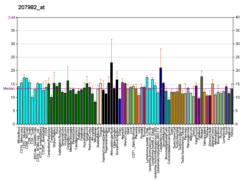Histone H1t is a protein that in humans is encoded by the HIST1H1T gene.[5][6][7]
Histones are basic nuclear proteins responsible for nucleosome structure of the chromosomal fiber in eukaryotes. Two molecules of each of the four core histones (H2A, H2B, H3, and H4) form an octamer, around which approximately 146 bp of DNA is wrapped in repeating units, called nucleosomes. The linker histone, H1, interacts with linker DNA between nucleosomes and functions in the compaction of chromatin into higher order structures. This gene is intronless and encodes a member of the histone H1 family. Transcripts from this gene lack polyA tails but instead contain a palindromic termination element. This gene is found in the large histone gene cluster on chromosome 6.[7]
References
- 1 2 3 GRCh38: Ensembl release 89: ENSG00000187475 - Ensembl, May 2017
- 1 2 3 GRCm38: Ensembl release 89: ENSMUSG00000036211 - Ensembl, May 2017
- ↑ "Human PubMed Reference:".
- ↑ "Mouse PubMed Reference:".
- ↑ Koppel DA, Wolfe SA, Fogelfeld LA, Merchant PS, Prouty L, Grimes SR (Jun 1994). "Primate testicular histone H1t genes are highly conserved and the human H1t gene is located on chromosome 6". J Cell Biochem. 54 (2): 219–30. doi:10.1002/jcb.240540210. PMID 8175896.
- ↑ Marzluff WF, Gongidi P, Woods KR, Jin J, Maltais LJ (Oct 2002). "The human and mouse replication-dependent histone genes". Genomics. 80 (5): 487–98. doi:10.1016/S0888-7543(02)96850-3. PMID 12408966.
- 1 2 "Entrez Gene: HIST1H1T histone cluster 1, H1t".
Further reading
- Drabent B, Kardalinou E, Doenecke D (1991). "Structure and expression of the human gene encoding testicular H1 histone (H1t)". Gene. 103 (2): 263–8. doi:10.1016/0378-1119(91)90284-I. PMID 1889752.
- Albig W, Drabent B, Kunz J, et al. (1993). "All known human H1 histone genes except the H1(0) gene are clustered on chromosome 6". Genomics. 16 (3): 649–54. doi:10.1006/geno.1993.1243. PMID 8325638.
- Albig W, Kioschis P, Poustka A, et al. (1997). "Human histone gene organization: nonregular arrangement within a large cluster". Genomics. 40 (2): 314–22. doi:10.1006/geno.1996.4592. PMID 9119399.
- Malanga M, Atorino L, Tramontano F, et al. (1998). "Poly(ADP-ribose) binding properties of histone H1 variants". Biochim. Biophys. Acta. 1399 (2–3): 154–60. doi:10.1016/s0167-4781(98)00110-9. PMID 9765591.
- Steger K, Klonisch T, Gavenis K, et al. (1999). "Expression of mRNA and protein of nucleoproteins during human spermiogenesis". Mol. Hum. Reprod. 4 (10): 939–45. doi:10.1093/molehr/4.10.939. PMID 9809674.
- Wellman SE, Song Y, Mamoon NM (1999). "Sequence preference of mouse H1(0) and H1t". Biochemistry. 38 (40): 13112–8. doi:10.1021/bi9914917. PMID 10529182.
- Strausberg RL, Feingold EA, Grouse LH, et al. (2003). "Generation and initial analysis of more than 15,000 full-length human and mouse cDNA sequences". Proc. Natl. Acad. Sci. U.S.A. 99 (26): 16899–903. doi:10.1073/pnas.242603899. PMC 139241. PMID 12477932.
- Gerhard DS, Wagner L, Feingold EA, et al. (2004). "The status, quality, and expansion of the NIH full-length cDNA project: the Mammalian Gene Collection (MGC)". Genome Res. 14 (10B): 2121–7. doi:10.1101/gr.2596504. PMC 528928. PMID 15489334.
- Olsen JV, Blagoev B, Gnad F, et al. (2006). "Global, in vivo, and site-specific phosphorylation dynamics in signaling networks". Cell. 127 (3): 635–48. doi:10.1016/j.cell.2006.09.026. PMID 17081983.




